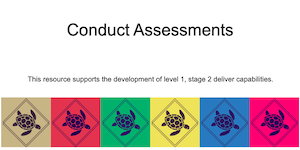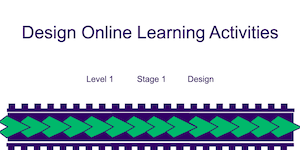All micro-learning resources
This page links you with all the micro-learning resources in the TVET Toolkit. On this page, they are sorted alphabetically by the title.
Be professional
Signposts is a professional development resource for new trainers, which was developed in New Zealand. There is a lot of useful information in this document.
Communicate clearly
Plain English is a style of communication that makes information easier to understand. This learning resource works through five steps to make written communication clearer.
Competency based training and assessment
This micro-learning resource explains the concepts of competency-based training and assessment.
Conduct assessments in TVET
This micro-learning resource explores what a TVET practitioner needs to think about when setting up a competency-based assessment, and includes a refresher on the principles of assessment.
Content and layout – checklist
This checklist will help you review the content and layout of your resources. The writer does the first review. There is an option for a second person to also reviewing the resource.
Create marking rubrics
This micro-learning resource gives TVET practitioners a basic understanding of how rubrics help to assess performance. It explains the advantages and disadvantages of using rubrics.
Design assessments- Steps
This micro-learning resource explains eight steps to design good assessments. This begins by understanding your learners and ends with reviewing your assessment.
Design online learning activities
This micro-learning resource explains some benefits of online learning and the key things trainers need to consider when deciding to deliver training online.
Do more with less
This document has seven practical tips for trainers on how they can make learning and assessment material on a small budget or when resources are limited.
Employer engagement toolkit
This toolkit introduces a four-step process for teachers, TVET leaders, and career advisors to bridge the gap between young people and employers.

Evaluate and improve your training
This micro-learning resource explains a structured approach to evaluating your training and. It uses a practical example to work the three steps to take after you have run your training.

Glossary
This micro-learning resource explains the meaning of words that are often used in TVET. It will be a valuable resource to refer to as you work through the Toolkit resources.

Guide to Gender-Responsive Learning Materials Development
This guide is designed to be used as a tool to enhance gender equality considerations in learning materials. It will help understanding the different learning needs of women/girls to help them reach their full potential.

Improving the image of TVET
This document reports on a virtual conference hosted by UNESCO-UNEVOC in 2018. It was attended by 346 participants from 82 countries. The conference explored strategies to improve the image of TVET.

Introduction to competency-based assessment (CBA)
This micro-learning resource introduces the basic core concepts of competency-based assessment. It explains the benefits of CBA, different types of evidence, and the key aspects of a good assessment.

Introduction to embedding foundation skills
This micro-learning resource explains the groups of skills commonly known as foundation skills. It provides a practical three-step approach to embedding foundation skills into the design of TVET

Join a community of practice
This micro-learning resource explains the purpose and benefits of a community practice. It also provides seven tips for a successful community of practice.

Know about and responding to difference
Signposts is a professional development resource for new trainers, which was developed in New Zealand. There is a lot of useful information in this document. The Toolkit references the different sections of the document separately.
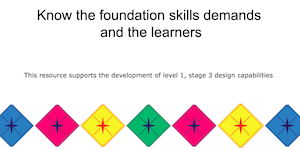
Know the foundation skills demands and the learners
This micro-learning resource helps TVET practitioners find the foundation skills in a TVET course using trigger words. It also introduces diagnostic assessment to identify learners’ current foundation skills using practical examples across a range of industries.

Make your class engaging for learners
Signposts is a professional development resource for new trainers, which was developed in New Zealand. There is a lot of useful information in this document. The Toolkit references the different sections of the document separately.

Manage your classroom
Signposts is a professional development resource for new trainers, which was developed in New Zealand. There is a lot of useful information in this document. The Toolkit references the different sections of the document separately.

Plan a lesson
This micro-learning resource uses a practical example to explore the process of lesson planning. This includes an overview of Blooms Taxonomy and how to draw on this model to design your lessons.

Plan your training and deliver the goods
Signposts is a professional development resource for new trainers, which was developed in New Zealand. There is a lot of useful information in this document. The Toolkit references the different sections of the document separately.

Provide assessment feedback to learners
This micro-learning resource has guidance for trainers on how and when to provide assessment feedback to learners. It covers the importance of providing balanced and meaningful feedback that will help learners improve.

Put Read Aloud on your MS Word Toolbar
Read Aloud is a feature in Microsoft Word. It can read out a document for you. You need to have Microsoft Word installed on your computer. You also need speakers or headphones.

Reflect on your teaching
Signposts is a professional development resource for new trainers, which was developed in New Zealand. There is a lot of useful information in this document. The Toolkit references the different sections of the document separately.

Set up a program or course – Checklist
This checklist is designed to help you think about the different things involved in setting up a programme. There may be other things to consider that are not on this checklist.

Support and encourage women in trades
This article is based on research about how to support women to work as tradespeople in male dominated workplaces. It discusses the benefits of a diverse workforce as well as ways to attract and retain women in trades industries.

Teach difficult vocabulary to embed reading skills development in TVET
This micro-learning resource presents various activities to build learners’ vocabulary. The resource includes an authentic example to illustrate each activity.
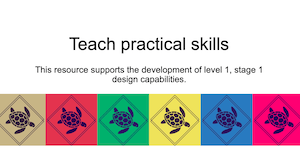
Teach practical skills
This micro-learning resource explains:
- how we learn for competence
- different types of learning activities
- Peyton’s four-step approach to teaching practical skills.

TVET benefits
This micro-learning resource will help you to understand the core benefits of TVET. It is designed to help TVET practitioners to share these benefits with stakeholders – industry, communities, families, and learners.

Use graphic organisers to embed writing skills development
This micro-learning resource introduces graphic organisers as an engaging way to support learners to develop writing skills in a vocational context.

Use speaking frames to embed speaking and listening skills development
This micro-learning resource explains how teachers and trainers can use speaking frames to embed speaking, listening, and language skills development in a vocational context.
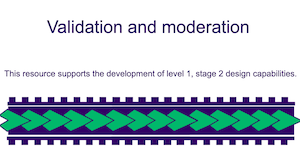
Validation and moderation
This micro-learning resources explains how validation and moderation support quality assurance in TVET. The resource introduces the:
- Principles of assessment
- Rules of evidence
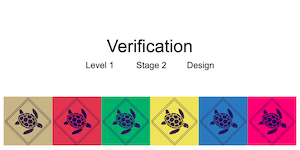
Verification
This micro-learning resource explains the practice of verification and how it can be used as a part of the assessment process in competency-based assessment.
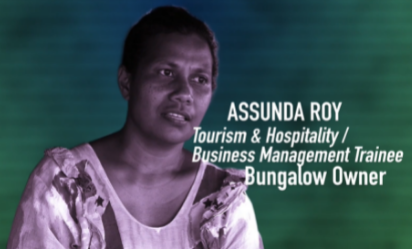
Video: Benefits of TVET for Assunda Roy
In this video, Assunda Roy explains how TVET helped her set up an accommodation business.

Video: Benefits of TVET for disabled female learners
In this video, the Vanuatu Skills Partnership explain how TVET has provided opportunities for Vanessa Siro, a woman with a disability.

Video: Benefits of TVET for female learners – Erima Nunumbal
In this video Erima Nunumbal explains how TVET study has provided her opportunities in starting up a tour guide business which is often more male-orientated in Vanuatu.

Video: Benefits of TVET for female learners – Gael Waki
In this video Fremden Yanhambath from the Vanuatu Skills Partnership explains how involving female trainers has benefited women learners in new ways.
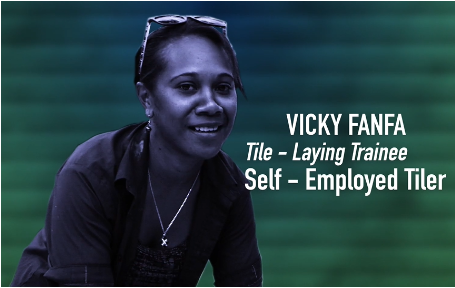
Video: Benefits of TVET for female learners – Vicky Fanfa
In this video Vicky Fanfa explains the personal and career benefits that TVET study has brought her in working as a tiler.

Video: Benefits of TVET for Kaliova Bilo
This video features Kaliova Bilo. He explains how studying TVET has taken him across the world and given him a life he would never have dreamed of.

Video: Benefits of TVET for Mike Kumar
This video features Mike Kumar who explains how his TVET study in Fiji has had a positive effect on his life and why he would recommend it for everyone to consider.

Video: Benefits of TVET for Shirley Worwor
In this video Shirley Worwor shares her experience with TVET and how she started her own business and helped other women in her community.

Video: How TVET can empower women
In this video, stakeholders from Vanuatu explain how TVET empowers women.

Video: Sanma hats, partnering in TVET
This video showcases the story of how a partnership brokered by the Vanuatu Skills Partnership helped women in Vanuatu develop their technical and business skills.

Video: What competency-based assessment means to Nelson Beti
This video features a trainer from the Solomon Islands called Nelson Beti. He explains what competency-based learning and assessment means to him.

Who is involved in TVET?
This micro-learning resource explains the main groups of people involved in TVET. It also explains their roles.

Write assessment questions
This micro-learning resource is designed to help trainers write good assessment questions and tasks. It gives examples of the many different types of questions and the general rules for writing good questions.

Write assessment schedules
This micro-learning resource will help TVET practitioners to understand what assessment schedules are and how they help when marking assessments. It includes a step-by-step guide with examples to help create assessment schedules.

Write good learning resources
This micro-learning resource explores five key principles to guide you as you design learning resources. At the end, there is an annotated examples of a learning resources that draws on these principles.



